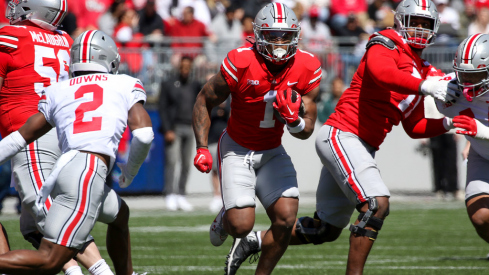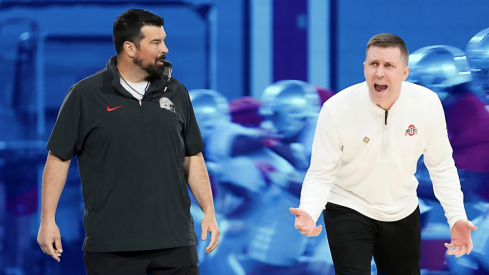
Ohio State's offensive output against Central Florida was perhaps masked by the Buckeye offense's sloppy play, particularly in the second half. Ohio State was only stopped when they stopped themselves. Yet this sloppiness is itself an issue that must be addressed. Another exemplary rushing performance by Braxton Miller also begs the question of whether he can continue to shoulder this workload for OSU and, relatedly, whether the Buckeyes have other playmakers who can step up.
UCF: Pretty Standard Really
The Knights kept things fairly basic against Ohio State. But part of the spread option's appeal is that ideally it forces a defense to remain basic to address the changed arithmetic. UCF clearly did not want to get beat deep, and thus featured either cover-2 with two deep safeties or loose cover-1. UCF did sneak their free safety up a la Miami—particularly either when OSU used an H-Back or when when a second back like Corey Brown came into the backfield (see video below). UCF also cheated their defender over the slot into the box. But they were also more likely to play with two deep safeties on passing downs.
Ohio State was happy to take what UCF gave them because it fit well with OSU's strengths. OSU's offensive line was generally able to control the LOS, particularly when UCF did not commit secondary members against the run. This was especially true for LT Jack Mewhort, LG Andrew Norwell, and C Corey Linsley, who are quickly turning into a dominant trio on the line's left side.
UCF also gave Miller some easy pickings. For instance, on Miller's first touchdown run, the Buckeyes went five wide. UCF responded by walking their back seven out of the box. With an athlete like Miller, this is stealing.

UCF did not make this mistake again, but nonetheless do not expect another defense to give Ohio State this look. Similarly, UCF gave a textbook example of why a defense does not want to play man-coverage against an athletic quarterback. UCF is in cover-1. Note how the play side linebacker turns to cover the slot receiver, leaving a large hole for Miller.
Miller is obviously the Buckeyes' premier playmaker, so anytime a team wants to make these basic errors against the Buckeyes, OSU will readily take advantage of it. As noted, Ohio State also responded to loose secondary coverage to hit bootleg play action and sprint-out flood routes.
Miller has the most confidence with these routes and threw a nice ball in such situations. Given that UCF was employing cover-2, particularly on passing downs, Ohio State also used a large percentage of smash routes, where Miller would hit the hitch route versus loose coverage.

Notably, OSU did not attack vertically. However, this was likely more a result of UCF not giving up the deep route and allowing OSU to attack underneath. But on the one opportunity that was available, which was Brown on a corner route, Miller underthrew the football, allowing the sinking corner to make an interception. Miller must continue to work on this aspect, as he is currently trying to aim the football rather than throw. While OSU did not push the issue and it did not inhibit their performance versus the Knights' scheme, OSU must still establish that they can push the ball vertically when defenses try to take away the Buckeyes' strengths.
Against UCF, however, the biggest hindrance to OSU was OSU. And it was not simply turnovers and penalties. Instead, OSU had repeated breakdowns of guys not running the correct play. It was particularly noticeable at running back. Bri'onte Dunn and Rod Smith had their share of lapses, which could perhaps be attributable to limited game reps. However, Carlos Hyde had two blown assignments himself before his injury, demonstrating an endemic issue. An offense cannot successfully function with such repeated breakdowns.
PlayMakers Wanted?
Perhaps because of these miscues, the offensive coaching staff became increasingly reliant upon Miller. He ended up with 27 carries, a heavy workload for any quarterback. That naturally begs the question whether this is sustainable and, if not, what OSU can do to remedy the issue. For starters, 27 carries may be a misleading number. As noted, OSU had a number of broken plays. On a handful of occasions Miller had no choice but to take off or eat the ball. That puts Miller in the low 20s in carries. That can be broken down further, with another 5-6 representing called pass plays (scrambles, sacks), with the remaining being either called runs or read/option keeps.
The immutable fact is that the spread-option offense is predicated upon the quarterback running the football. For instance, in his three years starting for Urban Meyer, Tim Tebow averaged almost 17 carries per game. So once you remove the blown plays, Miller did not have that many additional opportunities. Further, Miller is simply OSU's biggest threat, so the coaching staff is going to rely on his legs when they need to make a play.
Nonetheless, it would be helpful not only to Miller, but also to having a diversified offense, for Miller's carries to be in the 15 range. The question becomes how to get there. Noticeably, the coaching staff has not exhibited a large amount of faith in the Buckeye tailbacks to carry the load. That became increasingly evident after Hyde's injury, but Hyde only had seven carries prior to leaving. Dunn shows a lot of promise running the football, with good vision, a quick burst through the hole, and an ability to finish runs off, but he cannot be utilized until he does not have such mental miscues. Further, as Meyer indicated in his press conference, the coaches are still trying to determine where Jake Stoneburner best fits.
However, as Meyer also noted, one player that has clearly emerged is Corey Brown. Playing in the infamously named "Percy Harvin" slot role, Brown has shown an ability to get open and make plays after getting the football both in the passing games and on reverses. OSU threw the full panoply of wide receiver screens to Brown—jailbreak, flash (as seen below), and bubble—and as the game progressed, increasingly tried to utilize him.
Look for Brown to get increased opportunities, including in the option and run game.
The other big development for OSU would be the successful return of Jordan Hall at tailback. Hall was the clear No. 1 halfback this spring, not only on the edge but also running between the tackles. Particularly for Ohio State's inside zone play, the halfback needs to make one cut and go. This suits Hall well, as he is more quick than fast. OSU's offense with Hall in the backfield and Brown in the slot suddenly becomes more dynamic. The bottom line is whether it is because of scheme or lack of trust in their running backs, the Buckeyes have made little use of other base running plays such as counter-trey (other than with Miller running it) beyond inside zone. OSU needs to establish these plays as the season goes along to fully utlize Meyer's offensive system.
Cal: A Quick Primer
As Meyer indicated during his presser, Cal bases from a 'Bear' Defense, a la Double Eagle, which Ohio State has not seen in any extensive manner since playing Pete Carroll's USC defenses. At its base, the Bear defense covers up the center with a NG and both guards with 3-techniques, with the inside linebackers then responsible for the 'C' gaps.

Generally, this defense will play a one-high safety coverage behind the front. As you may expect, this defense is dedicated first and foremost to stopping the run by eating up the offensive line and preventing combo blocks. It is weakest off-tackle, where the bubbles present themselves. It will be interesting to examine how OSU reacts to this defense in two respects. One, it makes it difficult to run Ohio State's inside zone play. Does OSU respond by altering the halfback's path and/or using more power and counter trey? Two, is OSU able to pull these defenders out of the box via formation and/or taking advantage of numbers in the pass game? It will thus schematically present a good opportunity to see how the Buckeye offense diversifies and builds off what they have done thus far.
Update
Below are highlights of Cal's defense playing Oregon's analogous spread-option offense last fall. As you can see, Cal continues to play the Bear against Oregon's 3 and 4 WR formations, resulting in single-high coverage.

